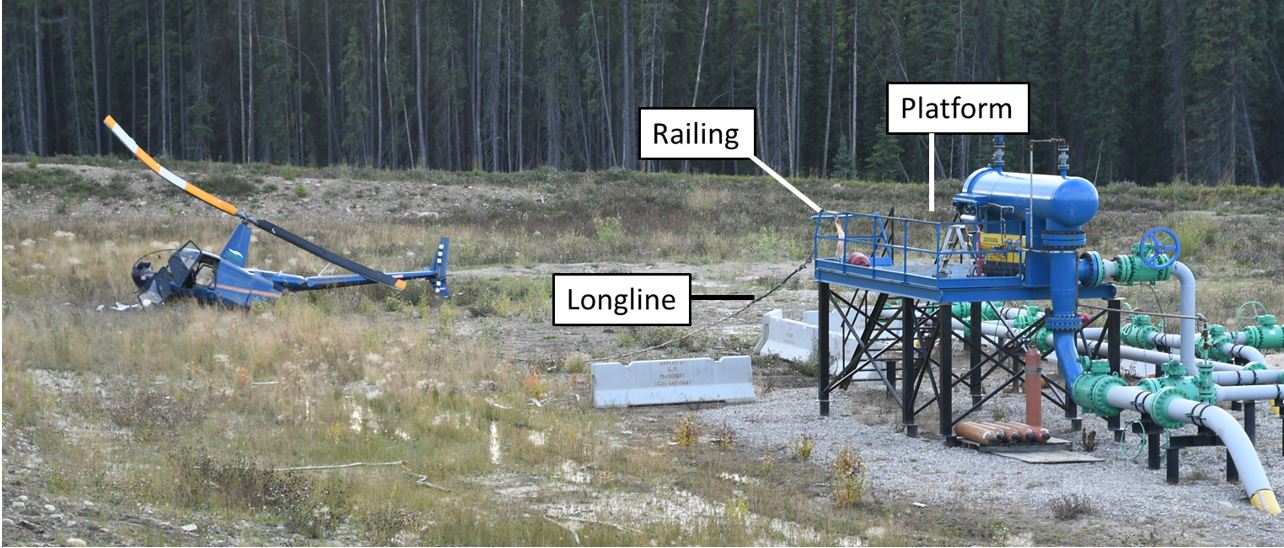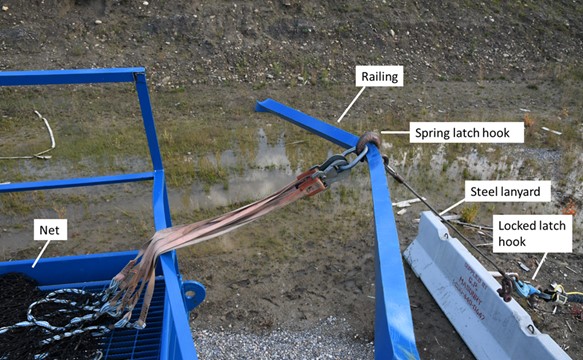Collision with terrain
Synergy Aviation Ltd.
Robinson Helicopter Company (RHC) R44 II, C-GNEC
Grande Cache, Alberta, 30 NM ENE
The Transportation Safety Board of Canada (TSB) investigated this occurrence for the purpose of advancing transportation safety. It is not the function of the Board to assign fault or determine civil or criminal liability. This report is not created for use in the context of legal, disciplinary or other proceedings. See Ownership and use of content. Masculine pronouns and position titles may be used to signify all genders to comply with the Canadian Transportation Accident Investigation and Safety Board Act (S.C. 1989, c. 3).
History of the flight
At 0919Footnote 1 on 25 August 2023, the Robinson Helicopter Company (RHC) R44 II helicopter (registration C-GNEC, serial number 11577) operated by Synergy Aviation Ltd. departed the company’s remote base, a gas plant, approximately 46 nautical miles (NM) east-northeast of Grande Cache, Alberta. The purpose of the flight was to pick up an empty cargo net at a multi-gas well battery,Footnote 2 approximately 13 NM west of the base. From there, the helicopter was to fly to another gas-well battery to retrieve pipeline integrity gauges and then return to the 1st battery (Figure 1).
When the pilot arrived at the multi-gas well battery, he landed near a work platform but did not shut down the helicopter. He then exited the helicopter and connected the 100-foot longline and cargo net, which was on the platform, to the cargo hook of the helicopter. The pilot got back in the running helicopter and lifted off into a hover.
The pilot initiated a vertical climb, observing the longline and cargo net through the window in the pilot’s door. Once the helicopter had cleared the work platform, the pilot turned his attention from the load under the helicopter to the front of the helicopter and began forward flight toward the next site.
During the transition to forward flight, the helicopter did not respond to the pilot’s flight control inputs. Unknown to the pilot, the longline had snagged a railing on the work platform.
As the pilot attempted to maintain control of the helicopter, the main rotor rpm began to decay. Given the likelihood of a crash, the pilot steered the helicopter away from the piping and tanks, subsequently colliding with terrain at 0931. The longline remained attached to the helicopter and the work platform railing (Figure 2).
The pilot was wearing the available safety belt, consisting of a lap strap and shoulder harness.
The pilot was not wearing his helmet because it was being repaired. There is no regulation or company policy requiring pilots to wear helmets.
The pilot was able to contact company personnel by pushing a button on the satellite tracking / emergency messaging system unit located on top of the instrument panel. Company personnel then contacted first responders. The pilot used his cellphone to text personnel in the area for help. Within 20 minutes of sending the first text, he received first aid from another helicopter pilot who had landed at the accident site.
Approximately 1 hour later, the occurrence pilot, who was seriously injured, was airlifted to hospital by air ambulance helicopter.
The Cospas-Sarsat system did not receive a signal from the 406 MHz emergency locator transmitter (ELT).Footnote 3
Pilot information
The investigation determined that the pilot held the appropriate licence for the flight in accordance with existing regulations. The pilot held a valid commercial pilot licence – helicopter, which was endorsed for multiple helicopter types, including the Robinson R44 series. He had accumulated approximately 4926 hours total flight time in all aircraft types.
The pilot had been employed by Synergy Aviation Ltd. since September 2016. At the time of the occurrence, his total time on the Robinson R44 series of helicopters was 4796 hours.
This was the 3rd day of the pilot’s 15-day work schedule, and his 1st flight of the day. A review of both the pilot’s work schedule and rest schedule indicated that fatigue was not likely a factor in this occurrence.
External load training
The Canadian Aviation Regulations (CARs)Footnote 4 require that operators train their crew for the aerial work to be conducted, in this case external load operations. In addition, the Commercial Air Services Standards describe the ground and air emergency training related to external load operations.Footnote 5 The company did not have specific emergency training involving external loads or related equipment.
The pilot’s company training record showed that external load training was conducted on 16 March 2023. The training consisted of the following exercises:
Pick up load off ground in a controlled state.
Take off, make a circuit and place the load near a specific spot.
Pick up load and move horizontal [sic] to a second spot 50m away.
Pick up and hold load stationary for 1 minute.Footnote 6
The training flight took about 1 hour to complete these competencies.
Aircraft information
The R44 II is a 4-seat helicopter with a single-reciprocating engine (Lycoming IO-540-AE1A5). It has a 2-bladed, semi-rigid main rotor system. The helicopter had no known deficiencies before or during the occurrence flight.
The last inspections completed on the helicopter were a 50-hour inspection on 02 August 2023 at 3847.9 hours total airframe time, and a 100-hour inspection on 24 July 2023 at 3806.4 hours total airframe time.
The helicopter was equipped with both an electric and a mechanical load release system.Footnote 7 Both systems were found to be functional after the accident.
The helicopter was operating within its weight-and-balance and centre-of-gravity limits.
The helicopter was not equipped with a flight data recorder or cockpit voice recorder, nor was either required by regulation.
Flight-path data was recovered from the satellite tracking device used by the company for flight-following and emergency communicating. The flight-path data showed that the flight from the remote base to the multi-gas well battery was approximately 10 minutes.
Equipment
The longline was equipped with a locked latch hook. This type of hook has a locking mechanism that prevents the hook’s keeper from opening, which can mitigate the risk of snagging (Figure 3, top image). The end of the steel lanyard that was attached to the locked latch hook had a spring latch hook installed (Figure 3, bottom image). This type of hook does not have a mechanism to prevent the hook’s keeper from opening, and this is the hook that became snagged on the platform’s railing.
Emergency locator transmitter
The Cospas-Sarsat system did not receive a signal from the ELT. The ELT was removed from the helicopter at the accident site and the switch was found in the ARM position. The ELT was attached to its mount with the manufacturer’s hook-and-loop fastener systemFootnote 8 at a downward angle of 45°. The ELT did not activate during the accident.
The ELT installed in the helicopter was designed for fixed-wing aircraft, but was allowed to be installed in helicopters if mounted at a 45° downward angle. The ELT’s G-switch, the mechanism that causes the ELT to transmit a signal following an impact, only functions in one direction. An ELT that is designed for helicopters functions in 6 possible directions: up, down, right, left, forward and rearward.
The European Union Aviation Safety Agency (EASA) published a memo regarding ELT installations and made the following note:
[…] during a helicopter crash, the direction of the impact may easily differentiate from the main aircraft axis. Nevertheless, it should be noted that this is not the unique solution for helicopters. There are products currently available on the market that are designed specifically for helicopters and/or designed to sense forces in several axes.Footnote 9
The CARs do not specifically prescribe multi-axis G-switch ELTs for helicopters. ELTs are required to meet design standard Canadian Technical Standard Order (CAN-TSO) 126b or later. The ELT installed on the helicopter met this requirement.
Wreckage and impact site information
When investigators arrived at the accident site, the lanyard that had snagged on the railing of the work platform was still attached (Figure 4). There was little damage to the front of the helicopter. The helicopter had impacted the ground on its right side. The main rotor blades were distorted from impacting the ground while turning. The fuselage was significantly damaged. There were no signs of pre-existing mechanical problems with the helicopter.
Weather information
The company’s remote base does not have an aviation weather reporting station. The pilot obtained weather information from NAV CANADA’s graphic area forecasts (GFAs), aerodrome routine meteorological reports (METAR), and aerodrome forecasts (TAF) from Grande Prairie Airport (CYQU), Edson Airport (CYET), and Whitecourt Airport (CYZU), all in Alberta.
The METAR from the closest station to the accident site (CYET) reported the following weather at 0900:
- Winds calm
- Visibility of ⅛ statute miles in fog
- Vertical visibility of 200 feet
- Temperature 7 °C, dew point 7 °C
- Altimeter setting 30.25 inches of mercury
The weather at the company’s remote base and the battery was conducive to visual flight rules (VFR) flight, with little fog in the area. The investigation determined that the weather was not a factor in this occurrence.
TSB laboratory reports
The TSB completed the following laboratory report in support of this investigation:
- LP142/2023 – ELT Analysis
Safety action taken
Shortly after the accident, Synergy Aviation Ltd. sent out an internal memo noting the following required actions:
- All loads are to be set and removed from the ground adjacent but clear of the platforms.
- All lanyards with the spring latch systems are to be removed from service and replaced with a locked latch style hook with a manual release.
- All longline operations require the pilot to remove the aircraft door to ensure the best visibility of the external load and/or end of the longline.
- A review of all operations associated with the pilot operating contracts as well as site hazard identification.
Safety messages
Including emergency procedures in external load training helps prepare pilots to respond appropriately to emergencies during external load operations.
It is important for operators that conduct external load operations to use equipment that mitigates or eliminates snagging risks.
Although ELTs with single-axis G-switches are permitted to be installed in helicopters, operators need to be aware that these units may not function in the event that the force of impact differs from the installation angle.
This report concludes the Transportation Safety Board of Canada’s investigation into this occurrence. The Board authorized the release of this report on . It was officially released on .



